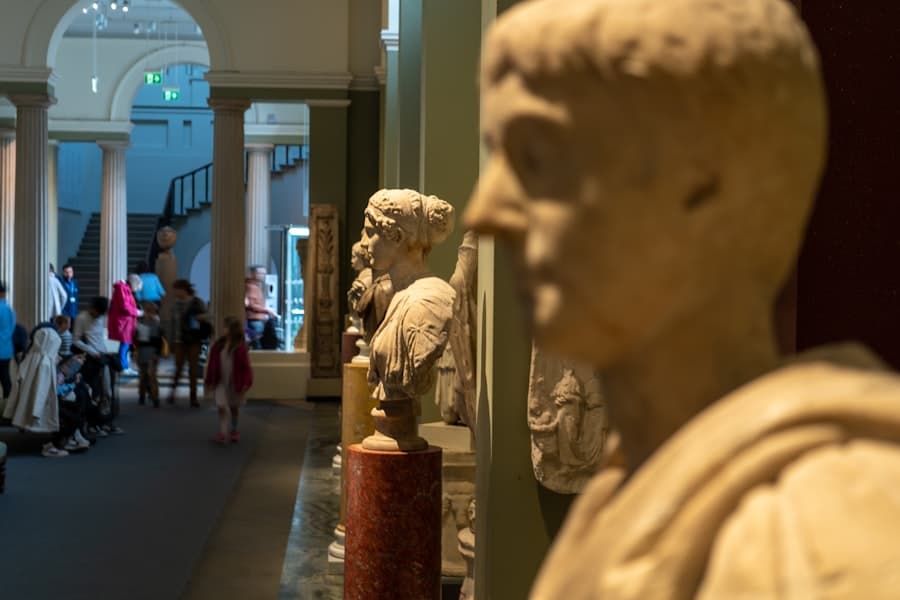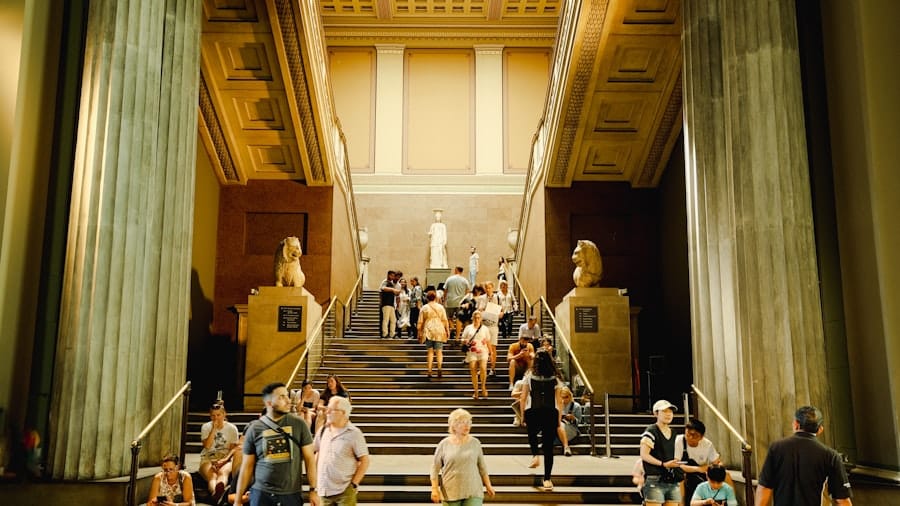Augmented Reality (AR) has emerged as a transformative technology in various sectors, and museums are no exception. By overlaying digital information onto the physical world, AR creates immersive experiences that can enhance the way visitors interact with exhibits. This technology allows museums to present historical narratives and artifacts in a more engaging manner, bridging the gap between the past and the present.
As museums strive to attract diverse audiences and adapt to the digital age, AR offers innovative solutions that can captivate visitors and enrich their understanding of history. The integration of AR into museum experiences is not merely a trend; it represents a fundamental shift in how cultural institutions operate. Traditional museum displays often rely on static information panels and guided tours, which can sometimes fail to engage visitors fully.
This personalized approach not only enhances the educational value of exhibits but also fosters a deeper emotional connection to the artifacts on display. As museums continue to explore the potential of AR, they are redefining what it means to experience history.
Key Takeaways
- AR in museums enhances visitor engagement by providing interactive and immersive experiences.
- Case studies show that AR in ancient history exhibits can bring artifacts to life and provide context for historical objects.
- AR technology enhances learning and understanding by offering in-depth information and interactive storytelling.
- AR plays a crucial role in preserving and restoring ancient artifacts by providing digital replicas and interactive experiences.
- Challenges in implementing AR in museums include cost, technical limitations, and the need for specialized content creation.
The Impact of AR on Visitor Engagement
The introduction of AR technology in museums has significantly altered visitor engagement levels. By providing interactive elements, such as 3D reconstructions or animated narratives, AR captures the attention of visitors in ways that traditional exhibits may not. For instance, when a visitor points their smartphone at an ancient artifact, they might see a virtual representation of how that object was used in its original context.
This kind of interaction not only piques curiosity but also encourages visitors to spend more time exploring exhibits, leading to a richer overall experience. Moreover, AR can cater to various learning styles, making it accessible to a broader audience. Visual learners benefit from seeing 3D models and animations, while auditory learners can engage with narrated content or soundscapes that enhance the storytelling aspect of an exhibit.
This multifaceted approach to engagement is particularly beneficial in museums that host diverse groups, including families, school groups, and international tourists. By accommodating different preferences and learning styles, AR fosters inclusivity and ensures that all visitors can derive value from their museum experience.
Case Studies of AR in Ancient History Exhibits

Several museums around the world have successfully implemented AR technology in their ancient history exhibits, showcasing its potential to enhance visitor engagement and education. One notable example is the British Museum’s “Ancient Egypt: Rediscovering a Lost World” exhibit, which utilized AR to bring ancient artifacts to life. Visitors could use their smartphones or tablets to scan QR codes next to artifacts, revealing interactive 3D models and animations that illustrated the daily life of ancient Egyptians.
This immersive experience allowed visitors to visualize how these objects were used in their historical context, deepening their understanding of ancient Egyptian culture. Another compelling case is the Archaeological Museum of Athens, which introduced an AR application that allows users to explore ancient Greek sites and artifacts through their mobile devices. By pointing their devices at specific exhibits, visitors could access detailed information about the history and significance of each artifact, as well as view reconstructions of ancient structures that no longer exist.
This application not only enhances the visitor experience but also serves as a valuable educational tool for students and researchers interested in ancient Greek history.
How AR Technology Enhances Learning and Understanding
AR technology serves as a powerful educational tool by transforming passive observation into active learning. When visitors engage with AR content, they are not merely looking at artifacts; they are interacting with them in meaningful ways. For example, an AR application might allow users to manipulate a 3D model of an ancient artifact, rotating it to view it from different angles or zooming in on intricate details.
This hands-on approach fosters a deeper understanding of the object’s significance and craftsmanship. Furthermore, AR can contextualize historical narratives by providing additional layers of information that enrich the visitor’s experience. For instance, an exhibit on ancient Rome might include an AR feature that transports visitors to a virtual reconstruction of the Colosseum during its heyday.
By experiencing the sights and sounds of this iconic structure in its historical context, visitors gain insights into Roman society, architecture, and entertainment practices that would be difficult to convey through text alone. This immersive learning experience encourages curiosity and critical thinking, prompting visitors to ask questions and seek further knowledge about the past.
The Role of AR in Preserving and Restoring Ancient Artifacts
In addition to enhancing visitor engagement and learning, AR technology plays a crucial role in the preservation and restoration of ancient artifacts. Many museums face challenges related to the deterioration of physical objects due to environmental factors or human interaction. By creating digital replicas through AR, museums can provide visitors with access to artifacts without risking damage to the originals.
These digital representations can be used for educational purposes or even for virtual exhibitions that reach wider audiences. Moreover, AR can assist conservators in their restoration efforts by providing detailed visualizations of artifacts before and after restoration processes. For example, an AR application might allow conservators to overlay digital images of an artifact’s original state onto its current condition, helping them identify areas that require attention or repair.
This technology not only aids in preserving cultural heritage but also allows museums to document their restoration processes for future reference and research.
Challenges and Limitations of Implementing AR in Museums

Despite its numerous advantages, implementing AR technology in museums is not without challenges. One significant hurdle is the cost associated with developing and maintaining AR applications. Creating high-quality content requires substantial investment in both technology and expertise.
Many smaller museums may struggle to allocate sufficient resources for such initiatives, leading to disparities in access to innovative experiences across different institutions.
For instance, not all visitors may have access to smartphones or tablets capable of running advanced AR applications.
Furthermore, issues related to connectivity can impact the user experience; if a museum’s Wi-Fi is unreliable or if there are insufficient charging stations for devices, visitors may become frustrated rather than engaged. Museums must carefully consider these factors when designing AR experiences to ensure they are accessible and enjoyable for all visitors.
Future Trends and Innovations in AR for Ancient History Exhibits
As technology continues to evolve, so too will the applications of AR in museums. One promising trend is the integration of artificial intelligence (AI) with AR experiences. AI can analyze visitor interactions with AR content to provide personalized recommendations or adapt narratives based on individual interests.
This level of customization could lead to even more engaging experiences that resonate with diverse audiences. Another exciting innovation is the potential for collaborative AR experiences that allow multiple users to interact with digital content simultaneously. Imagine a group of visitors standing together in front of an ancient artifact while using their devices to view different aspects of its history or significance.
This collaborative approach could foster social interaction among visitors while enhancing their collective understanding of the exhibit. Furthermore, advancements in hardware technology may lead to more sophisticated AR experiences that do not rely solely on smartphones or tablets. Wearable devices like smart glasses could provide hands-free access to augmented content, allowing visitors to engage with exhibits without being tethered to their devices.
Such innovations could revolutionize how museums present ancient history, making it more immersive and accessible than ever before.
The Potential of AR to Revolutionize Museum Experiences
The integration of augmented reality into museum exhibits represents a significant opportunity for cultural institutions to enhance visitor engagement and education. By providing interactive experiences that bring ancient history to life, museums can foster deeper connections between visitors and the artifacts on display. As demonstrated by successful case studies around the world, AR has the potential to transform how we understand and appreciate our shared heritage.
While challenges remain in implementing this technology effectively, ongoing advancements promise exciting possibilities for the future of museum experiences. As museums continue to innovate and adapt to changing visitor expectations, augmented reality will undoubtedly play a pivotal role in shaping the way we explore and learn about ancient history. The potential for AR to revolutionize museum experiences is immense, offering new avenues for discovery and understanding that were previously unimaginable.
Augmented Reality (AR) is revolutionizing the way museums present ancient history, offering visitors immersive experiences that bring the past to life. This innovative technology allows museum-goers to interact with historical artifacts and environments in ways that were previously unimaginable. For those interested in how technology is enhancing our daily lives beyond museums, you might find the article on Unlock the Possibilities with Samsung Galaxy S22 intriguing. It explores how cutting-edge technology in smartphones, like the Samsung Galaxy S22, is opening new avenues for AR applications, making it more accessible and integrated into everyday experiences.
FAQs
What is AR?
AR stands for Augmented Reality, which is a technology that superimposes digital information such as images, videos, or 3D models onto the real world, typically viewed through a smartphone or tablet.
How is AR being used in museums?
AR is being used in museums to enhance the visitor experience by bringing ancient history to life. It allows visitors to see 3D reconstructions of ancient artifacts, historical figures, and scenes from the past overlaid onto the physical exhibits.
What are the benefits of using AR in museums?
Using AR in museums can provide a more engaging and interactive experience for visitors, helping them to better understand and connect with ancient history. It can also attract a younger audience who are more familiar with digital technology.
Are there any drawbacks to using AR in museums?
One potential drawback of using AR in museums is that it may distract visitors from the physical exhibits and the authentic experience of being in a museum. Additionally, not all visitors may have access to the necessary technology, such as smartphones or tablets, to fully participate in the AR experience.
How is AR content created for museums?
AR content for museums is created using a combination of 3D modeling, animation, and programming. This content is then integrated into AR apps or platforms that visitors can access on their smartphones or tablets while visiting the museum.

